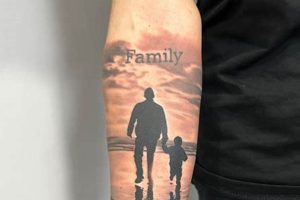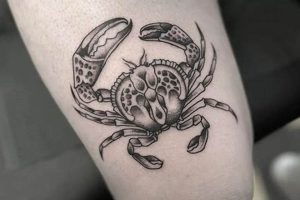Designs inspired by Indigenous American cultures encompass a wide range of visual elements, often drawing from tribal symbols, animals with spiritual significance, and traditional art forms. These designs can represent clan affiliations, personal narratives, or reverence for nature. For example, a bear tattoo might symbolize strength and protection, while a feather could represent honor or connection to the spiritual realm.
Connecting with one’s heritage or expressing admiration for Indigenous cultures are key motivations behind choosing such designs. These tattoos can serve as powerful reminders of ancestral legacies and the rich history of these communities. It is crucial, however, to approach these designs with respect and understanding, acknowledging their cultural significance and avoiding appropriation. Historically, tattoos held deep spiritual meaning within Indigenous communities, tied to rituals, storytelling, and individual identity. The resurgence of interest in these designs underscores the importance of learning about their origins and significance.
Further exploration of this topic will delve into specific design elements, the importance of consulting with Indigenous artists, and the ethical considerations surrounding cultural appropriation. Understanding the historical and cultural context of these powerful symbols is paramount to appreciating their true meaning and ensuring respectful representation.
1. Tribal Affiliation
Authenticity in designs inspired by Indigenous American cultures hinges significantly on tribal affiliation. Acknowledging and respecting the specific traditions of a tribe is paramount. Designs hold distinct meanings across different tribes, and using a symbol without understanding its cultural context can constitute misappropriation.
- Respect for Tribal Heritage
Each tribe possesses unique artistic traditions and symbolic representations. Choosing a design based on one’s own tribal heritage ensures the tattoo holds personal and cultural significance. For instance, a Haida design would carry different meanings and artistic styles compared to a Lakota design. Respecting these distinctions is fundamental.
- Avoiding Cultural Misappropriation
Using symbols from a tribe one does not belong to can be deeply offensive. It disregards the sacred meaning these symbols hold for the respective community. Appropriating designs trivializes the cultural heritage they represent. Thorough research and understanding are crucial before choosing a design.
- Connecting with Ancestral Lineage
For individuals with Indigenous heritage, tribal-specific tattoos offer a powerful connection to their ancestors. These designs can represent clan lineages, historical narratives, or spiritual beliefs specific to their tribe. Such tattoos serve as a visible embodiment of cultural identity and pride.
- Consulting with Tribal Artists
Engaging with artists from the specific tribe whose designs are being considered is essential. This collaboration ensures the design is created and applied respectfully, honoring the cultural protocols and traditions surrounding tattooing within that community.
Ultimately, tribal affiliation serves as a guiding principle for individuals seeking culturally appropriate and meaningful tattoos inspired by Indigenous American traditions. Honoring tribal heritage through respectful representation fosters a deeper appreciation for the rich cultural diversity within these communities.
2. Animal Symbolism
Animal symbolism plays a vital role in designs inspired by Indigenous American cultures. Specific animals hold profound spiritual and cultural significance, representing various qualities and serving as guides or protectors. These symbolic meanings vary among different tribes, reflecting diverse beliefs and traditions. Understanding the specific connotations associated with each animal is essential for ensuring respectful and accurate representation within a tattoo design.
The bear, often revered for its strength and protective nature, frequently symbolizes courage and leadership. Eagle imagery, prominent in many Indigenous cultures, embodies power, freedom, and connection to the spiritual realm. The wolf can signify loyalty, family, and intuition, while the turtle often represents wisdom, longevity, and grounding. These examples highlight the depth and complexity of animal symbolism within Indigenous traditions. A bear tattoo might be chosen to evoke inner strength, while an eagle tattoo could express a yearning for spiritual growth.
Selecting an animal for a tattoo requires careful consideration of its cultural significance within the specific tribal context being referenced. Consulting with Indigenous artists and cultural experts is crucial for ensuring accurate representation and avoiding misappropriation. Such consultations demonstrate respect for Indigenous knowledge and contribute to the preservation of cultural heritage. Ultimately, incorporating animal symbolism in these designs provides a powerful means of connecting with ancestral traditions and expressing personal values aligned with these rich cultural narratives.
3. Cultural Sensitivity
Cultural sensitivity is paramount when considering designs inspired by Indigenous American cultures. These designs carry deep spiritual and historical significance within their respective communities, and appropriating them without understanding or respecting their cultural context can cause significant harm. A lack of cultural sensitivity can perpetuate stereotypes, commodify sacred symbols, and erase the rich history and traditions associated with these designs. For example, using a headdress motif without understanding its significance as a symbol of leadership and honor earned through specific achievements within certain tribes trivializes its meaning and disrespects those who hold the right to wear it. Conversely, engaging with Indigenous artists and seeking their guidance ensures designs are created and worn with respect, honoring the cultural heritage they represent.
Understanding the historical context of Indigenous tattooing traditions is crucial for demonstrating cultural sensitivity. Historically, tattoos served various purposes within Indigenous communities, from marking rites of passage to representing clan affiliations and spiritual beliefs. Approaching these designs with a genuine desire to learn and appreciate their cultural significance fosters respectful engagement. Collaborating with Indigenous artists not only ensures accurate representation but also supports the continuation of these artistic traditions. This collaborative approach strengthens cultural preservation efforts and counters the negative impacts of cultural appropriation. Choosing a design based on genuine appreciation and understanding, rather than superficial aesthetics, reflects cultural sensitivity and honors the traditions being represented.
Respectful engagement with Indigenous American cultures requires ongoing learning and a commitment to cultural sensitivity. Educating oneself about the historical and contemporary significance of these designs helps prevent unintentional harm and promotes cross-cultural understanding. Recognizing the potential for cultural appropriation and actively working to avoid it is a critical step towards fostering respectful relationships with Indigenous communities and honoring their rich artistic heritage. By prioritizing cultural sensitivity, individuals can contribute to a more inclusive and equitable representation of Indigenous cultures.
4. Artist Consultation
Consultation with Indigenous artists represents a crucial step in the process of acquiring tattoos inspired by Indigenous American cultures. This consultation serves as a cornerstone of respectful engagement, ensuring designs are culturally appropriate, historically accurate, and imbued with genuine meaning. Direct collaboration with an Indigenous artist fosters a deeper understanding of the symbolism, traditions, and artistic conventions associated with specific tribal affiliations. For example, an individual seeking a tattoo inspired by Northwest Coast art should ideally consult with an artist from that region to ensure the design’s authenticity and respect for its cultural context. This approach avoids the pitfalls of misappropriation and misrepresentation that can occur when designs are chosen without proper guidance.
The importance of artist consultation extends beyond mere aesthetic considerations. It establishes a direct link to the cultural knowledge and lived experience of Indigenous communities. Artists can provide invaluable insights into the historical and spiritual significance of various design elements, ensuring the chosen tattoo reflects a genuine appreciation for the culture it represents. Moreover, engaging with Indigenous artists directly supports their artistic practices and contributes to the preservation of cultural heritage. This economic empowerment helps sustain Indigenous communities and ensures their traditions continue to thrive. By commissioning work from Indigenous artists, individuals actively participate in cultural preservation and demonstrate a commitment to ethical and respectful engagement.
Ultimately, artist consultation serves as a vital bridge between individual expression and cultural respect. It transforms the process of acquiring a tattoo from a purely aesthetic pursuit into a meaningful act of cultural exchange. Navigating the complexities of cultural appropriation requires careful consideration and a willingness to learn from those who hold the cultural knowledge. Prioritizing artist consultation ensures that designs inspired by Indigenous American cultures are created and worn with integrity, honoring the rich traditions they represent.
5. Authenticity
Authenticity in designs inspired by Indigenous American cultures represents a critical consideration, encompassing far more than just the visual elements of a tattoo. It delves into the respectful engagement with cultural heritage, the ethical implications of appropriation, and the importance of honoring the traditions and beliefs associated with these designs. Authenticity requires a deep understanding of the historical and spiritual context of the chosen imagery, acknowledging its significance within the specific Indigenous community it originates from.
- Tribal Specificity
Authentic designs demonstrate respect for tribal specificity. Each tribe possesses unique artistic traditions, symbolic representations, and protocols surrounding tattooing. A truly authentic tattoo acknowledges these distinctions, avoiding generic or pan-Indigenous imagery that homogenizes diverse cultures. For instance, a design incorporating elements specific to the Din (Navajo) culture should not be conflated with designs from other tribes, such as the Lakota or Haida. Respecting these cultural boundaries is fundamental to authenticity.
- Artist Collaboration
Working with Indigenous artists is crucial for ensuring authenticity. These artists possess the cultural knowledge and artistic skills necessary to create designs that are both aesthetically beautiful and culturally respectful. Collaborating with an artist from the specific tribe whose traditions are being referenced ensures the design aligns with their artistic conventions and avoids misappropriation. This collaborative process also supports Indigenous artists and contributes to the preservation of their cultural heritage.
- Meaning and Purpose
Authenticity requires understanding the meaning and purpose behind the chosen design. Indigenous tattoos traditionally held deep spiritual and cultural significance, often representing clan lineages, personal narratives, or spiritual beliefs. A truly authentic tattoo reflects this depth of meaning, moving beyond mere aesthetics to embody a genuine connection to the culture it represents. Researching the historical and cultural context of the chosen imagery is essential for ensuring its authentic representation.
- Ongoing Learning and Respect
Authenticity is not a static achievement but an ongoing process of learning and respect. It requires a commitment to continuous education about Indigenous cultures, traditions, and contemporary issues. Engaging with Indigenous communities, attending cultural events, and supporting Indigenous artists are all ways to deepen understanding and demonstrate respect. This ongoing engagement ensures that appreciation for Indigenous cultures remains informed and authentic.
Authenticity in designs inspired by Indigenous American cultures represents a commitment to honoring the rich history, traditions, and artistic expressions of these communities. It requires more than just choosing a visually appealing design; it necessitates a deep understanding of the cultural context, respectful collaboration with Indigenous artists, and a continuous commitment to learning and cultural sensitivity. By prioritizing authenticity, individuals can ensure their tattoos serve as genuine expressions of appreciation and respect for Indigenous cultures.
6. Design Significance
Design significance within the context of Indigenous-inspired tattoos transcends mere aesthetics. Each element carries profound cultural, spiritual, and historical meaning, reflecting the rich tapestry of Indigenous American traditions. Understanding this significance is paramount for ensuring respectful representation and avoiding the misappropriation of culturally sensitive imagery. A design’s meaning can vary significantly across different tribes, highlighting the importance of research and consultation with Indigenous artists and cultural experts.
- Storytelling and Narrative
Many Indigenous tattoo designs serve as visual narratives, depicting ancestral stories, historical events, or personal journeys. Specific symbols and motifs can represent clan lineages, spiritual beliefs, or significant life experiences. For example, a tattoo depicting a Thunderbird might represent a connection to the spiritual realm and the power of transformation, while a series of geometric patterns could tell a story of a family’s history and migration. Understanding the narrative embedded within a design is crucial for appreciating its full significance.
- Spiritual Symbolism
Spiritual symbolism permeates Indigenous tattoo traditions. Designs often incorporate elements representing powerful spiritual figures, sacred animals, or natural forces. These symbols can serve as protective talismans, expressions of spiritual beliefs, or reminders of one’s connection to the ancestral world. A bear paw tattoo, for instance, might symbolize strength and protection, while a feather could represent honor and connection to the spiritual realm. Recognizing the spiritual significance of these designs is essential for respectful representation.
- Connection to Nature
Indigenous cultures maintain a deep connection to the natural world, and this reverence is often reflected in their artistic traditions. Tattoo designs frequently incorporate elements from nature, such as animals, plants, celestial bodies, and natural phenomena. These elements can symbolize the interconnectedness of all living things, the cyclical nature of life, or the importance of environmental stewardship. A tattoo depicting a wolf, for example, might symbolize loyalty and connection to family, while a depiction of a tree could represent strength, growth, and resilience. Understanding the significance of these natural elements within Indigenous worldviews provides deeper insight into the meaning of the designs.
- Cultural Identity and Belonging
For individuals with Indigenous heritage, tattoos can serve as powerful expressions of cultural identity and belonging. Tribal-specific designs can represent clan affiliations, ancestral lineages, or adherence to specific cultural traditions. These tattoos can act as visible markers of cultural pride and connection to one’s heritage. For example, a tattoo incorporating traditional Haida art forms could signify belonging to the Haida Nation and a commitment to upholding their cultural values. Recognizing the role of tattoos in expressing cultural identity is essential for understanding their significance within Indigenous communities.
By understanding the design significance within Indigenous-inspired tattoos, individuals can move beyond superficial aesthetics and engage with these artistic traditions in a meaningful and respectful way. Recognizing the cultural, spiritual, and historical context of these designs fosters a deeper appreciation for the rich heritage they represent and ensures their continued relevance within Indigenous communities.
Tips for Choosing Culturally Sensitive Designs
Careful consideration is crucial when selecting designs inspired by Indigenous American cultures. These tips offer guidance for navigating the process respectfully and ensuring meaningful representation.
Tip 1: Research Tribal Affiliations: Thorough research into specific tribal affiliations is paramount. Designs and their meanings vary significantly between tribes. Understanding the specific cultural context prevents misappropriation and demonstrates respect for tribal heritage. For example, a design appropriate for a Lakota individual might hold a different meaning or be entirely inappropriate for someone from the Hopi tribe.
Tip 2: Consult with Indigenous Artists: Collaboration with Indigenous artists ensures authenticity and cultural sensitivity. Their expertise provides invaluable insights into appropriate design elements and their significance. This collaboration also supports Indigenous artists and contributes to cultural preservation.
Tip 3: Understand Symbolism: Delve deeply into the symbolism associated with specific designs. Animal imagery, geometric patterns, and other elements hold profound cultural and spiritual meaning within Indigenous traditions. Understanding these meanings ensures the chosen design aligns with one’s intentions and avoids misrepresentation.
Tip 4: Avoid Generic “Pan-Indian” Designs: Generic or “pan-Indian” designs that lack tribal specificity often perpetuate stereotypes and erase the rich diversity of Indigenous cultures. Prioritize designs rooted in the specific traditions of a particular tribe to ensure respectful representation.
Tip 5: Consider Placement and Size: Placement and size of the tattoo can also carry cultural significance in some traditions. Researching these aspects or discussing them with an Indigenous artist ensures respectful representation and avoids unintentional cultural faux pas.
Tip 6: Focus on Meaning, Not Just Aesthetics: Prioritize the meaning and cultural significance of the design over purely aesthetic considerations. A culturally sensitive tattoo represents a commitment to honoring Indigenous traditions and should not be treated as a mere fashion statement.
Tip 7: Commit to Ongoing Learning: Cultural sensitivity requires ongoing learning and a commitment to understanding the complexities of Indigenous cultures. Continue to educate oneself about Indigenous history, traditions, and contemporary issues to ensure respectful engagement.
By adhering to these guidelines, individuals can ensure their choices honor Indigenous cultures and contribute to respectful representation. Meaningful engagement requires careful consideration, thorough research, and a genuine commitment to cultural sensitivity.
The following conclusion offers a final perspective on the importance of respectful representation and the ongoing need for cultural sensitivity within the realm of Indigenous-inspired tattoos.
Frequently Asked Questions
Addressing common inquiries regarding designs inspired by Indigenous American cultures promotes informed decision-making and fosters respectful engagement with these traditions.
Question 1: How can one avoid cultural appropriation when choosing an Indigenous-inspired tattoo?
Prioritizing consultation with Indigenous artists from the specific tribe whose artistic traditions are being considered is crucial. Thorough research into the cultural significance of specific designs is essential, ensuring respectful representation and avoiding the misappropriation of sacred symbols. Choosing designs based on one’s own heritage or opting for symbols that resonate personally without appropriating specific tribal imagery are viable alternatives.
Question 2: What is the significance of consulting with an Indigenous artist?
Indigenous artists possess invaluable cultural knowledge and artistic expertise. Their guidance ensures designs are authentic, historically accurate, and respectful of tribal traditions. Directly supporting Indigenous artists also contributes to the economic well-being of their communities and the preservation of cultural heritage.
Question 3: Are there specific designs considered more appropriate than others for non-Indigenous individuals?
Generally, designs directly referencing specific tribal affiliations or ceremonial practices are best avoided by those outside the respective communities. Exploring broader themes inspired by Indigenous art, such as nature-based imagery or geometric patterns, while remaining mindful of their cultural origins, can be a more respectful approach. Consulting with Indigenous artists remains crucial for guidance.
Question 4: What are the ethical implications of using Indigenous imagery without proper understanding?
Using Indigenous imagery without proper understanding can perpetuate harmful stereotypes, commodify sacred symbols, and erase the rich history and cultural significance associated with these designs. It disrespects Indigenous communities and contributes to the ongoing impacts of cultural appropriation.
Question 5: How can one learn more about the specific meanings of Indigenous designs?
Engaging with reputable sources of information, such as museums, cultural centers, and scholarly publications specializing in Indigenous art and history, provides valuable insights. Directly contacting tribal cultural representatives or participating in educational programs offered by Indigenous communities fosters deeper understanding.
Question 6: What is the best way to ensure a tattoo inspired by Indigenous cultures is created and worn respectfully?
Respectful representation necessitates thorough research, consultation with Indigenous artists, and a genuine commitment to understanding the cultural context of the chosen design. Prioritizing cultural sensitivity over purely aesthetic considerations ensures the tattoo honors Indigenous traditions and avoids perpetuating harmful stereotypes.
Respectful engagement with Indigenous cultures requires ongoing learning and a commitment to cultural sensitivity. Thorough research, consultation with Indigenous artists, and a deep understanding of design significance are crucial for ensuring meaningful and appropriate representation.
Further resources and information on Indigenous cultures and artistic traditions can provide a deeper understanding of this complex topic.
Conclusion
Exploring designs inspired by Indigenous American cultures requires careful navigation of cultural sensitivity, historical awareness, and artistic appreciation. Understanding the profound significance embedded within these designs, from tribal affiliations and animal symbolism to the importance of artist consultation and design authenticity, is paramount. Respectful representation honors the rich heritage and artistic traditions of Indigenous communities while avoiding the harmful impacts of cultural appropriation.
Ultimately, honoring the legacy of Indigenous American cultures through respectful engagement remains crucial. Continued learning, genuine appreciation for cultural diversity, and supporting Indigenous artists contribute to the preservation of these vital traditions for future generations. Choosing designs inspired by these cultures carries a responsibility to uphold their integrity and promote meaningful cross-cultural understanding.







